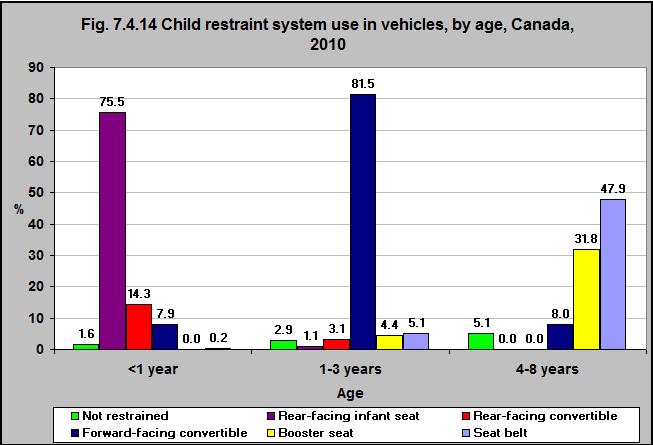Child restraint system use in vehicles, by age, Canada, 2010

Notes:
The appropriate restraint system for infants less than one year is a rear-facing seat. The appropriate restraint system for children aged 1 to 3 years is a forward-facing infant seat. The appropriate restraint system for children aged 4 to 8 years is a booster seat. A rear-facing convertible can convert to a forward-facing seat. A forward-facing convertible can convert to a rear-facing seat. 1
Source: CICH graphic created using data adapted from the Canadian National Survey on Child Restraint Use 2010. Transport Canada, in partnership with AUTO21.
https://www.tc.gc.ca/media/documents/roadsafety/Child_Restraint_Survey_2010.pdf – accessed June 24, 2017.
According to the Canadian Survey on Child Restraint Use 2010, 90% of infants were in a rear-facing seat in 2010.
82% of 1 to 3 year olds were in a forward-facing convertible seat.
32% of children 4 to 8 years were in a booster seat, 48% were in a seat belt and 5% were not restrained. 8% were in a forward-facing convertible seat.
In this 2010 survey, 91.4% of the population was using some type of child restraint in a moving vehicle.1
*Types of Seat Variables: Age Groups1
Rear-facing infant seat – under 1 year
Forward-facing infant seat – 1 to 4 years
Booster seat- 4 to 9 years
Seatbelt only – 9+ years
1Snowdon, Anne W., Hussein, A and Ahmed, E. (2010). Technical Report: Canadian National Survey on Child Restraint Use 2010. Completed for Transport Canada, in partnership with AUTO21. https://www.tc.gc.ca/media/documents/roadsafety/Child_Restraint_Survey_2010.pdf– accessed June 24, 2017.
Implications
The Council of Ministers of Transportation and Highway Safety in Canada has set a Road Safety Target that states 95% of all children who are passengers in vehicles should be properly restrained in the appropriate child restraint system.1 A number of strategies have been identified that could help meet this target. They include eliminating exemptions in child restraint laws; imposing higher fines; and imposing demerit points/or higher demerit points.2
1Transport Canada. 2001. Canada’s Road Safety Targets to 2010. http://publications.gc.ca/collections/Collection/T46-28-2001E.pdf – accessed June 24, 2017.
2Transport Canada Motor Vehicle Safety (with support from the Public Health Agency of Canada). 2011. Road Safety in Canada. https://www.tc.gc.ca/eng/motorvehiclesafety/tp-tp15145-1201.htm#s31 -accessed June 24, 2017.
